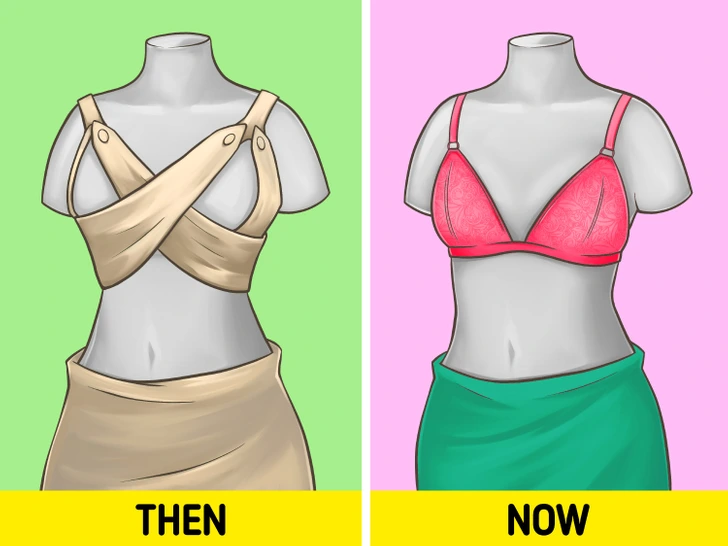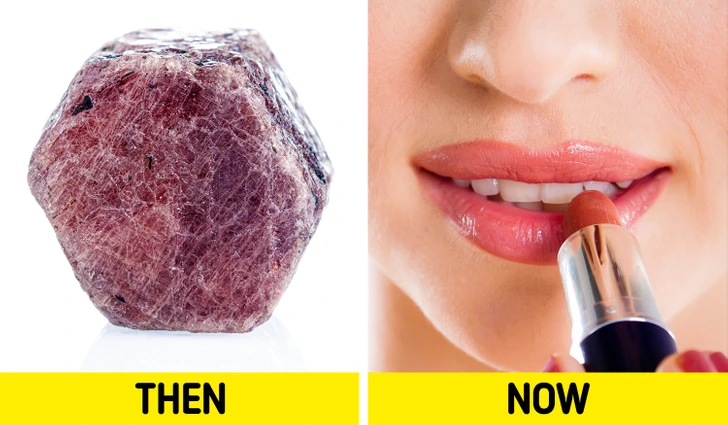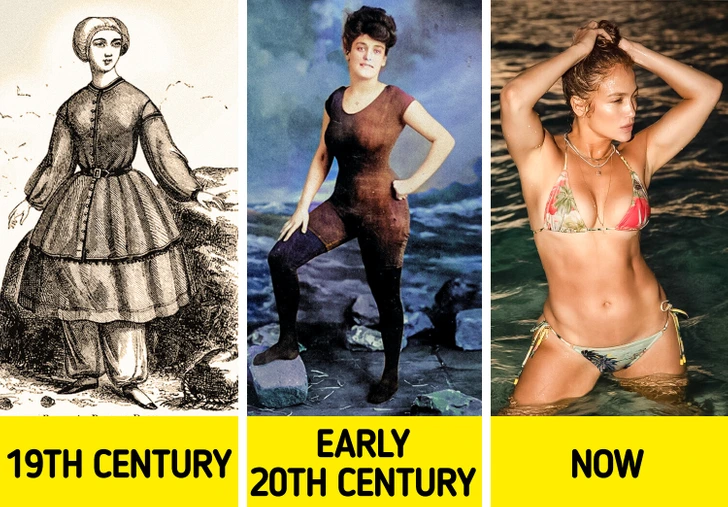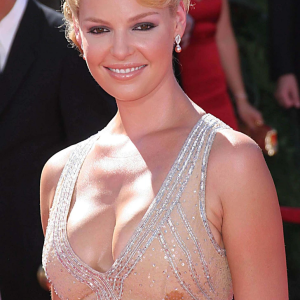From beauty staples to wardrobe essentials, many of the products women use today have gone through generations of evolution. What we now consider common and convenient once began as crude prototypes—shaped by necessity, fashion trends, and innovation. Let’s take a closer look at the fascinating transformation of eight key female-focused items and how they’ve adapted over the centuries to better serve modern life.
1. The Bra: From Ribbons to Revolutionary Design

The earliest known version of the modern bra was discovered in an Austrian castle and is estimated to be around 600 years old. These early garments resembled what we might now call a bralette—simple cloth structures with fabric bands and buttons used for breast support.
As corsets began to fade out of popularity in the 19th century, New York inventor Marie Tucek introduced a game-changer: the “breast supporter.” This device included a metal plate and cardboard base, covered in silk, with fabric cups that held the breasts in place. Her creation laid the foundation for what would eventually become the bra we know today.
Video:
A Brief History of the Bra: An Animated AI Enhanced History
Since then, bras have continued to evolve—introducing innovations like underwires, adjustable straps, memory foam cups, and wireless support for comfort and style in equal measure.
2. Mascara: From Ancient Ritual to Beauty Essential

The history of mascara stretches all the way back to Ancient Egypt. Men and women used a mixture known as kohl to darken their lashes, brows, and lids, not just for beauty but for spiritual protection. Kohl was typically made from galena, malachite, charcoal, soot, and even saliva.
Modern mascara didn’t emerge until the late 19th century when cosmetic companies began to develop safer, more refined formulas. Today’s mascara includes options for volume, length, curl, waterproof wear, and even natural, plant-based ingredients—highlighting how a once ritualistic practice has become a daily beauty staple.
3. Stockings: From Men’s Fashion to Feminine Symbol

Though often associated with women today, stockings—originally called hose—were first worn by men as early as the 12th century. These early versions were crafted from cloth and sewn to fit the legs.
It wasn’t until the 16th century that women began wearing stockings more widely. With the invention of knitting machines in the 1500s, silk and cotton stockings became more accessible. The 20th century brought about nylon stockings, revolutionizing legwear and making it a permanent fixture in women’s wardrobes.
4. Lipstick: Ancient Glamour That Stands the Test of Time

Lipstick has perhaps one of the oldest histories in cosmetics. Around 5,000 years ago, ancient Sumerians and people from the Indus Valley crushed gemstones to add shimmer and color to their lips and eyes. Egyptians, notably Cleopatra, used crushed carmine beetles to create deep red pigments.
Throughout history, lipstick has been viewed as everything from seductive to scandalous to empowering. The 20th century saw it become a symbol of independence and fashion. Now, it’s available in endless shades, finishes, and formulas—including clean, vegan, and long-wearing options.
5. Heeled Shoes: From Royalty to Runway

High heels didn’t begin as women’s fashion. In Ancient Egypt, platform sandals indicated status, while Persian horsemen wore heeled boots to secure their feet in stirrups. It wasn’t until the 16th century that heeled shoes transitioned into women’s fashion in Europe, thanks to influence from the French court.
Over time, heels evolved from functional riding tools to fashion icons, with stiletto heels making their debut in the mid-20th century. Today, whether flat or sky-high, heels continue to offer a blend of style, power, and elegance.
Video:
Women’s shoes have changed
6. Corsets: From Ancient Shaping to Modern Expression

The corset traces back to Minoan civilization in Crete, where both men and women wore tight-fitting garments to accentuate the waist. In later centuries, corsets became synonymous with European fashion, especially in the Victorian era, when waist-cinching silhouettes were a mark of beauty and class.
By the 20th century, corsets had largely fallen out of favor, replaced by bras and shapewear. But the modern fashion world has revived them—as outerwear, fashion statements, and costume pieces—celebrated for their structural elegance and empowered reinterpretation.
7. Disposable Menstrual Pads: From Basic Utility to Discreet Comfort

The first disposable menstrual pads appeared in the late 19th to early 20th centuries. These were rudimentary at best—essentially cotton wool rectangles wrapped in gauze. They were designed to be secured to undergarments using loops and belts, which were prone to shifting and discomfort.
Thankfully, menstrual products have evolved significantly. Modern pads now offer superior absorption, adhesive backing, wings for extra security, and ultra-thin designs for discreet wear. The menstrual care industry also includes options like period underwear, menstrual cups, and organic cotton pads, showing the evolution of both technology and user-focused design.
Video:
The History of Menstruation – Evolution of Menstruation Products
8. Swimsuits: From Modesty to Movement

In the 18th and 19th centuries, women’s bathing dresses were made from heavy materials like wool, with weighted hems to prevent them from floating in the water. These garments prioritized modesty over practicality, often covering from neck to ankle.
As cultural norms relaxed in the 20th century, swimsuits gradually became more form-fitting and functional. First, the arms and legs were exposed, then the midriff, leading to the birth of the bikini in 1946. Over the decades, swimsuits embraced everything from high-cut one-pieces to strappy two-pieces, designed for both performance and style.
Despite changing trends, the classic one-piece remains a favorite, now reimagined with sleek designs, tummy control, and UV-protective fabrics that make it as functional as it is flattering.
Reflecting Progress Through Design
These eight products highlight how far we’ve come—from crude solutions and limited functionality to personalized, inclusive, and performance-based designs. As women’s needs, values, and lifestyles have changed over the centuries, so too have the products that support them.
Modern versions of bras, cosmetics, hygiene products, and clothing reflect a deeper understanding of comfort, identity, and empowerment. The evolution continues as companies respond to demands for sustainability, transparency, and innovation.
And while the past may seem distant, each design improvement tells a story of resilience, creativity, and the desire to make life better—not just for women, but for everyone.


